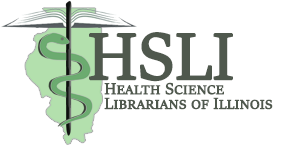On March 20, 2014, HSLI sponsored the CE class “Measuring What Matters to Stakeholders” as a pre-conference to the Illinois Association of College and Research Libraries conference. The session sparked a lively discussion between academic and hospital libraries about what to assess, how to assess it, and how to effectively communicate assessment results. The class was taught by Ruth Holst, Associate Director of the Greater Midwest Region, NN/LM.
Slides from the session are available on the HSLI website at http://hsli.org/conference/archive/2014/slides.pdf
Both academic and hospital librarians at the session reported being under pressure from administration to prove their value to the organization. Hospital librarians mentioned several recent library closures, underscoring the critical importance of stakeholder support to the survival of the library. Academic librarians spoke about campus wide initiatives to cut expenses. These cost-cutting measures do not exclude the library, and concerns were raised on how to protect vital services.
The first part of the class covered understanding the mission of the institution and making sure what the library does supports the institutional mission. Applying this perspective to assessment, hospital libraries need to find measures that show how the library supports patient care. Academic libraries need measures that show how the library affects student learning.
In addition to assessment to show value, librarians should also conduct assessment for service quality improvement. One unique idea discussed was recording bibliographic instruction sessions and sharing them with students after the class. This allows the students to review the material covered, and also allows the librarian to review his or her teaching. Another tool discussed that is of value for both internal quality assessment and for showing value was Gimlet (http://gimlet.us/). Gimlet is a comprehensive reference service tracking system that provides statistics on the usage of reference services, questions answered per staff member, time spent per question, and many other metrics.
Usage statistics are helpful in demonstrating library activities, but these implicit measures do not always fully illustrate how the library helps the institution meet its goals. One method discussed to assess explicit value was to interview users about a critical incident of use.” As an examples of this technique, an instructor would be asked to describe a time when they used the library with a student and then describe what changed in the student’s work or practices as a result of using the library. In a health care setting, a practitioner would describe a time when using library services resulted in a change to the care a patient received. Another example is to try to capture a time when the library had prevented an adverse event. In an academic setting, this could be asking students to describe a time when using the library saved them from performing poorly on an assignment.
Several methods to communicate assessment results back to stakeholders were presented. One new technique is to create a “library dashboard.” Dashboards are generally web-based and summarize a variety of library statistics. One example mentioned was Regent, http://www.regent.edu/lib/dashboard/home.cfm For more information on library dashboards, see the following webinar from the NN/LM South Pacific region https://webmeeting.nih.gov/p5ss78sss3i/?launcher=false&fcsContent=true&pbMode=normal
Dashboards quickly condense information about the library in an easy to read format. Being able to quickly and effectively present information about the value of the library to stakeholders is vitally important. Since opportunities to show the value of your library can happen unexpectedly, Ruth recommended that all librarians have an “elevator speech” prepared. The elevator speech condenses vital information about the importance of your library to meeting institutional goals into a short statement that can be delivered in the time it takes to take an elevator ride. With a speech prepared and rehearsed, the next time you find yourself in an elevator with your director, dean, vice president, or other administrator you will be ready to tell him or her how your library supports your institution.
